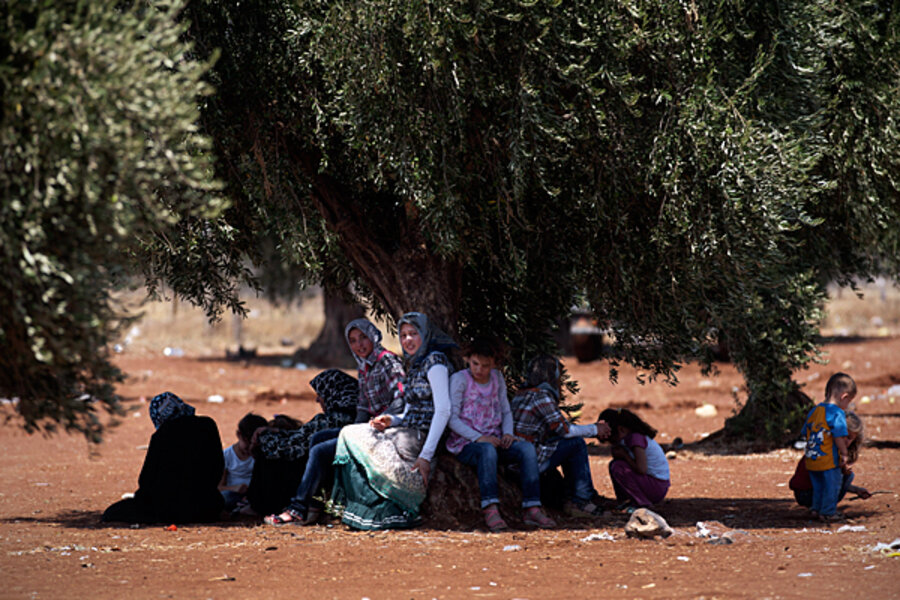Turkey wants safe haven for refugees in Syria. Will UN – or NATO – oblige?
Loading...
| Washington
Pressure is building for the international community to create a safe haven inside Syria for the thousands of Syrians uprooted by their country’s intensifying civil war.
With Turkey already at the threshold of 100,000 Syrian refugees, which Turkish officials have suggested could be their country’s limit, Syria’s neighbors will be looking to a high-level United Nations meeting this week to find ways to address Syria’s humanitarian crisis without simply leaving it to Turkey, Jordan, Lebanon, and others in the region to take on.
“We will emphasize that this burden now needs to be shared by the whole international community, not just by Syria’s neighbors,” Turkey’s Foreign Minister Ahmet Davutoglu said Monday, describing the stance he plans to take when the UN Security Council meets Thursday to discuss the humanitarian issues resulting from Syria’s 18-month-old conflict.
The New York meeting will be a test of the UN’s ability to unite and play a significant role in addressing the Syrian crisis after three Security Council vetoes by Russia and China of Syria resolutions. The most recent of those vetoes, in July, left other council members including the United States vowing to find partners outside the UN framework for addressing Syria.
The UN meeting, which will bring together the foreign ministers of Security Council members and other interested countries, will take place at the end of what Syrian activists say is now the deadliest month of the fighting, with more than 4,000 Syrians having died in August alone.
Turkey will press for an internationally-backed solution that allows uprooted Syrians to remain safely on their side of the border not only because Turkey already has received its “threshold” of refugees, regional experts say, but also because Turkey has learned the hard way the consequences of handling a refugee crisis on one’s own.
“Turkey’s lesson from the early 1990’s is that if you let a large number of refugees come in, they end up being your problem only,” says Soner Cagaptay, a Turkey expert at the Washington Institute for Near East Policy (WINEP), referring to when Turkey accepted about a half-million Iraqi-Kurd refugees who were fleeing Saddam Hussein and his gassing of Kurdish communities.
Mr. Cagaptay says Turkish officials have told him on recent visits to Ankara that 100,000 Syrian refugees would be Turkey’s limit, at which point it would demand that the international community find an alternative to simply allowing neighboring countries to meet the need.
Turkey would prefer that the UN come up with a response, but Cagaptay says he believes Turkey would turn to NATO if the Security Council remains deadlocked.
“The Turks are quite comfortable with the idea of NATO supporting a safe haven or humanitarian corridor,” he says, noting that Turkey participated in NATO-only operations in the Balkans.
“What they want to see is the participation of some international body to give whatever action is taken international legitimacy,” he says.
Some regional analysts and members of Congress have advocated for months that the US spearhead a coalition of the willing, either through NATO or in a more ad-hoc manner, to create safe havens or a humanitarian corridor inside Syria. The Obama administration has so far stopped short of that step, even after administration officials indicated after the last Security Council veto of measures meant to pressure Syrian President Bashar al-Assad that the US would move to act outside of the UN.
Secretary of State Hillary Rodham Clinton met Aug. 11 with Turkey’s Mr. Davutoglu and said at that time that the two countries would consider creating a Syrian no-fly zone – an idea she said would require “intense” study and planning.
But already at the time of the Clinton-Davutoglu meeting, some officials from both countries were suggesting that Syrian rebels were already carving out “de facto” and intermittent safe zones on their side of the border.
The opposition Syrian National Council has called for establishing safe havens along the 560-mile-long Turkish border and the 230-mile-long Jordanian border.
WINEP’s Cagaptay says that in reality, Turkey has a “make-do strategy” under which it is addressing the humanitarian needs of Syrians amassed across the border in what have become undeclared safe zones. The objective of providing food, water, and some medicines to Syrians on Syrian territory is to try to keep what has become a flow of some 2,000 refugees a day into Turkey from growing any larger, he says.
But the makeshift response is not seen as a long-term alternative to the “international legitimacy” that Turkey wants for what are becoming safe zones inside Syria. The international community’s stamp is important not just to reassure Syrians that they are safe remaining on their side of the border, regional experts say, but as a message to Mr. Assad that world powers won’t tolerate any attacks on uprooted Syrians.






